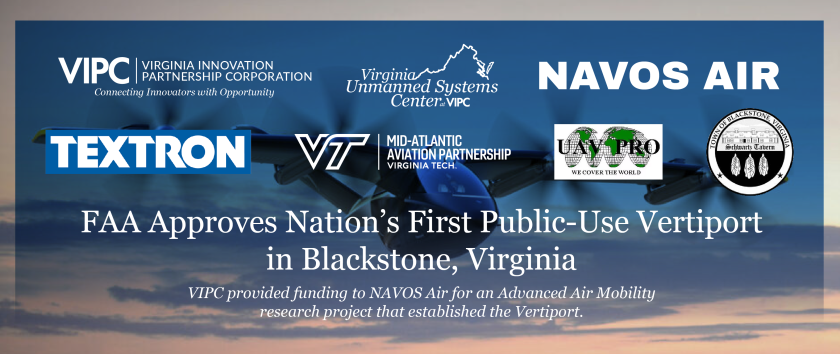“This action creates a path for the airport to establish the first licensed public-use Vertiport in the state and the nation.. NAVOS Air, a Virginia-based air navigation services company, was the proponent of the Vertiport, as part of a project funded by the Virginia Innovation Partnership Corporation (VIPC) through the Virginia Commonwealth Center of Innovation for Autonomous Systems (C2IAS) grant program,” according to a VIPC press release.
Blackstone Army Airfield (KBKT) is a dual-use airport for military and civilian flight operations. After it is licensed by the Virginia Department of Aviation, the Vertiport will be established and used as part of research on an end-to-end concept of operations NAVOS Air developed based on modifying and designing terminal instrument procedures and enroute infrastructure specifically for Uncrewed Aircraft System (UAS) and AAM use cases, with Vertiports serving as the anchors to that system. AAM is the next generation of the aviation industry that seeks to connect previously underserved markets with innovative aircraft powered by emerging technologies.
“Leveraging existing approved infrastructure methods modified for new use cases and research applications will enable AAM operations sooner while providing opportunities to inform the development of future air traffic management systems and facilities” said Matt Burton, the technical director at NAVOS Air. “Designating Vertiports is part of the beginning of real progress towards enabling AAM.”
According to the press release, NAVOS Air was the proponent of the Vertiport as part of a research project using an Uncrewed Aircraft System (UAS) to represent larger AAM vehicles for instrument flight operations research. These special instrument procedures have the potential to deliver UAS/AAM to airport locations, off-airport locations, and newly established Vertiports. Additionally, they will facilitate the integration of emerging airspace users with legacy users, while maximizing the efficiency and safety of airspace in this new era of aviation.
During its research, NAVOS Air also analyzed designating a heliport to be served by instrument procedures that were optimized for UAS operations. This allowed NAVOS Air to quickly work with the FAA when the guidance for Vertiport design was released in late 2022 to gain approval for the first Vertiport and take the next step to enabling AAM.
“We congratulate VIPC, Navos and the airport sponsor on their efforts to create the first public-use vertiport in the commonwealth,” said Greg Campbell, director of the Virginia Department of Aviation. “This development aligns with Virginia’s established role as a leader in the development unmanned systems and emerging technologies.”
The project was conducted with the Virginia Tech Mid-Atlantic Aviation Partnership (MAAP), which provided airworthiness review and flight authorization. UAV Pro enabled operations and safety management at Blackstone Army Airfield. Textron Systems operated the Textron Aerosonde UAS for the project’s flight tests.
VIPC established C2IAS in collaboration with Virginia Tech University and Old Dominion University for advancing unmanned systems technology. Its mission encompasses commercializing existing research, facilitating the creation of new companies, promoting applied research in unmanned systems, and driving substantial capital investment and job creation within the state of Virginia.
Earlier this year, VIPC conducted an economic impact study with NEXA Advisors of McLean that projects the AAM industry in Virginia has the potential to generate USD16 billion in new business activity and create more than 17,000 full-time jobs in the aerospace and supporting industries during the next 23 years. By 2045, it is anticipated that over 7.7 million passengers annually, which is equivalent to more than 21,000 passengers per day, will travel in AAM aircraft within Virginia.
For more information




